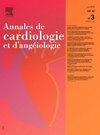Intérêt de la télésurveillance non invasive dans le contrôle du poids, des symptômes et la réduction des hospitalisations chez les patients insuffisants cardiaques : analyse d'une cohorte française sur 1 an
IF 0.3
Q4 Medicine
引用次数: 0
Abstract
Background
Heart failure (HF) is a severe condition associated with high rates of hospitalization and mortality. Early outpatient detection of symptoms and weight gain through remote medical monitoring of HF (HF-RM) could improve patient prognosis.
Objectives
To evaluate the effectiveness of HF-RM in managing congestion in HF outpatients and to analyze event rates over 12 months (HF-related hospitalizations and all-cause mortality), as well as associated costs.
Methods
We included patients enrolled in the HF-RM at our hospital from July 2020 to December 2022. For each patient, HF-RM relied on daily transmission of weight and symptoms via a connected scale. Any alerts related to weight gain or the onset of new symptoms were managed within 48 hours by the specialized HF team, including a telephone contact, NT-proBNP testing, and treatment adjustment if necessary. Data on HF-related hospitalizations and vital status were collected over a 12-month period before and after the implementation of HF-RM. Event rates were compared to expected values at the onset of HF-RM, based on patient profiles and data from the ESC-HF-LT registry. Cost analysis included costs associated with HF-RM, the specialized HF nurse, biological tests, and HF hospitalizations.
Results
Among the 147 patients included, the average age was 60 ± 12 years, and 75% were male. The average ejection fraction (EF) was 33 ± 11%, with 76% of patients presenting with reduced EF. During the HF-RM period, 85 alerts (54% of patients) led to a significant reduction in weight and symptoms within 30 days. The hospitalization rate decreased from 44.9% before the initiation of HF-RM to 11.6% afterward (p < 0.0001). The 12-month event rate was 15%, significantly lower than the expected 24.5% (p = 0.0002). The absence of transmitted alerts was strongly correlated with the absence of events (negative predictive value of 95.2%). The number of days spent at home increased, and costs significantly decreased.
Conclusion
HF-RM is associated with improved outpatient congestion control, reduced hospitalizations, and decreased healthcare costs. Further prospective, randomized studies are needed to better assess the impact of HF-RM on the progression of HF and its costs.
非侵入性远程监测在控制心脏衰竭患者体重、症状和减少住院率方面的重要性:法国1年队列分析
背景:心力衰竭(HF)是一种与高住院率和高死亡率相关的严重疾病。通过心衰(HF- rm)远程医疗监测,在门诊早期发现症状和体重增加,可改善患者预后。目的评估HF- rm在治疗HF门诊患者充血中的有效性,并分析12个月内的事件发生率(HF相关住院和全因死亡率),以及相关成本。方法纳入2020年7月至2022年12月在我院参加HF-RM的患者。对于每个患者,HF-RM依赖于通过连接秤的体重和症状的每日传播。任何与体重增加或新症状出现有关的警报都在48小时内由专门的心衰小组处理,包括电话联系、NT-proBNP测试和必要时的治疗调整。在实施HF-RM之前和之后的12个月内收集了与hf相关的住院和生命状况数据。根据患者资料和ESC-HF-LT注册表的数据,将事件发生率与HF-RM发病时的期望值进行比较。成本分析包括与HF- rm、专门的HF护士、生物检测和HF住院相关的费用。结果147例患者平均年龄60±12岁,男性占75%。平均射血分数(EF)为33±11%,76%的患者表现为EF降低。在HF-RM期间,85例(54%的患者)在30天内导致体重和症状显著减轻。住院率从开始使用HF-RM前的44.9%下降到开始使用HF-RM后的11.6% (p <;0.0001)。12个月事件发生率为15%,显著低于预期的24.5% (p = 0.0002)。没有传递警报与没有事件密切相关(负预测值为95.2%)。在家度过的天数增加了,成本显著降低。结论hf - rm与改善门诊拥塞控制、减少住院率和降低医疗保健费用有关。需要进一步的前瞻性随机研究来更好地评估HF- rm对HF进展及其成本的影响。
本文章由计算机程序翻译,如有差异,请以英文原文为准。
求助全文
约1分钟内获得全文
求助全文
来源期刊
CiteScore
0.60
自引率
0.00%
发文量
68
审稿时长
6-12 weeks
期刊介绍:
Organe scientifique de référence fondé en 1951, les Annales de cardiologie et d''angéiologie abordent tous les domaines qui intéressent quotidiennement les cardiologues et les angéiologues praticiens : neurologie et radiologie vasculaires, hémostase, diabétologie, médecine interne, épidémiologie et prévention.
Les Annales de cardiologie et d''angéiologie sont indexées aux grandes bases de données et publient rapidement, et en conformité avec les normes internationales de publication scientifique, des articles en français sur la pathologie cardiaque.

 求助内容:
求助内容: 应助结果提醒方式:
应助结果提醒方式:


